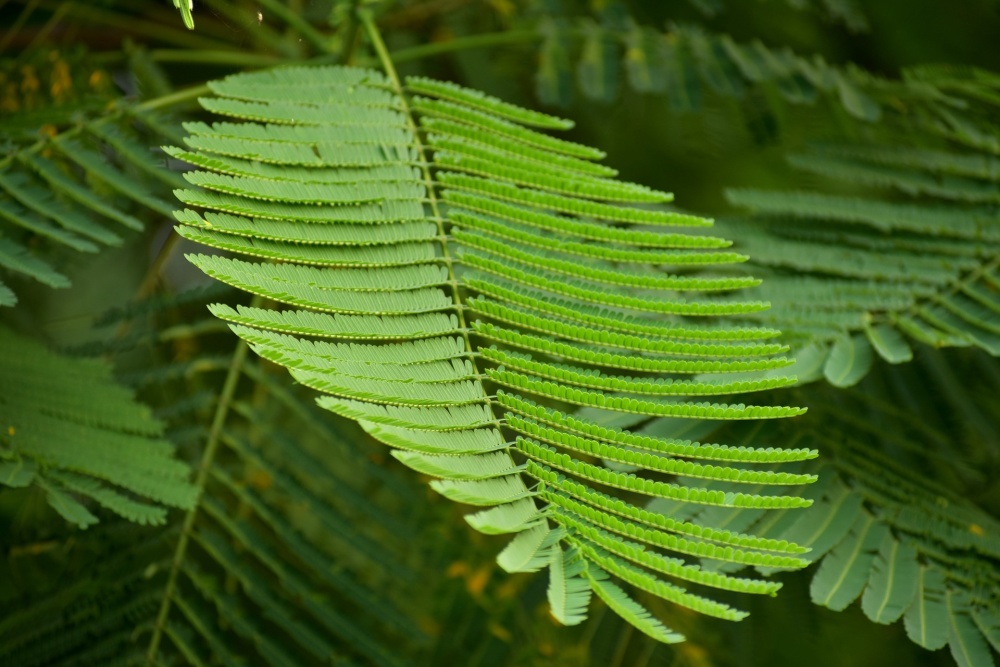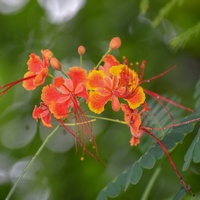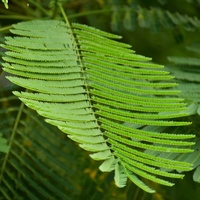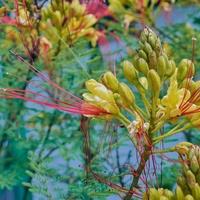Common name: Peacock flower
Other common names: Barbados flower fence, Barbados pride, Dwarf poinciana
Description
Peacock flower is a flowering shrub, or small tree thought to originate in tropical America and now widely cultivated in the tropics.
It is fast-growing and, under favourable conditions, may develop into a small tree 5 to 7 meters (16 to 23 ft) tall, though typically is a shrub 2 to 3 meters (6.5 to 9.8 ft) tall with multiple stems in a V-shape forming a wide-spreading crown. The branches are armed with small, needle-like spines, although some varieties are without spines.
Leaves are large, up to 30 cm (1 ft) long and twice-feathered, composed of numerous, small, dull green oblong leaflets, each 1 to 2 cm (0.4 to 0.8 in) long and arranged in opposite pairs along each leaf branch. They are evergreen in humid areas, remaining on the plant in all seasons, but some leaf-fall does occur in areas with a pronounced dry season.
The flowers are spectacular, with exceptionally long stamens and large petals that are either bright yellow, red-orange or red with pale margins, depending on the variety. They are borne in loose clusters on long, erect spikes at the ends of the branches almost year-round but are at their fullest during spring, summer and autumn. Fertilised flowers develop into flat, oblong, green seedpods up to 12 cm (4.7 in) long that then turn brown when mature and remain unopened on the plant for some time.

Use
Peacock flower is admired for its delicate, feathery foliage and near-continuous flowering display, which also helps attract butterflies to the garden. It is a good candidate for an informal hedge, privacy screen, windbreak or barrier plant and its tolerance to light salt spray makes it a suitable seaside garden plant.
Honeybees actively visit the flowers, and there are reports of this producing a good quality honey.
Climate
Grows naturally in sub-humid to moderately humid subtropical and tropical lowland climates, generally areas with annual lows of 11 to 25°C, annual highs of 19 to 35°C, annual rainfall of 500 to 2000 mm and a dry season of 3 to 7 months, extending to 12 months with irrigation or groundwater.
Growing
New plants are usually grown from seed, which germinate readily but benefit from soaking in hot water. Seedlings, often found growing beneath established plants, can be carefully dug up and transplanted to a new site or put in a container.
Performs best on free-draining, clay, loam or sand soils of a slightly acid to slightly alkaline nature, generally with a pH of 5.5 to 8.0, and on sites with full to partial sun exposure. It has good tolerance to limestone soils, drought and light salt spray conditions.
It benefits from an annual light pruning to develop a strong structure with a fuller form and encourage flowering. Pruning is best done in the dry season when the plant is dormant.
Problem feature
It is listed as a weed in more than one reference publication. Still, there does not appear to be any record of it anywhere as a serious weed, despite its widespread distribution and naturalisation. Its assessment by the Hawaii Pacific Weed Risk Assessment (HPWRA) project has not found it to be a high weed risk for Hawaii. And it is assessed as low risk by the Assessment of Non-Native Plants in Florida's Natural Areas (IFAS).
The seed are reportedly poisonous if ingested.
Where it grows
References
Books
-
Adams, C. D. 1972, Flowering plants of Jamaica, University of the West Indies, Mona, Greater Kingston
-
Allen, O. N. & Allen, E. K. 1981, The Leguminosae : a source book of characteristics, uses, and nodulation, University of Wisconsin Press, Madison, Wisconsin
-
Francis, J. K. and Liogier, H. A. 1991, Naturalized exotic tree species in Puerto Rico, General technical report SO-82, USDA Forest Service, Southern Forest Experiment Station, New Orleans
-
Gilman, E. F. 1997, Trees for urban and suburban landscapes, Delmar Publishers, Albany, New York
-
Little, E. L. et al. 1964 and 1974, Common trees of Puerto Rico and the Virgin Islands (2 volumes), Forest Service, U.S. Department of Agriculture (USDA), Washington D.C.
-
Macmillan, H. F. 1943, Tropical planting and gardening : with special reference to Ceylon, 5th ed, Macmillan Publishing, London
-
Menninger, E. A. 1962, Flowering trees of the world for tropics and warm climates, 1st ed., Heathside Press, New York
-
Morton, J. F. 1971, Exotic plants, Golden Press, New York
-
Nelson, L. & Shih, R. & Balick, M. J., 2007, Handbook of poisonous and injurious plants, 2nd ed, New York Botanical Gardens, Springer, New York
-
Oakman, H. 1995, Harry Oakman's what flowers when : the complete guide to flowering times in tropical and subtropical gardens, University of Queensland Press, St. Lucia, Queensland
-
Parrotta, J. A. 2001, Healing plants of peninsular India, CABI Publishing, Wallingford, Oxfordshire
-
Perkins, K. D. & Payne, W. 1981, Guide to the poisonous and irritant plants of Florida, Florida Cooperative Extension Service, Gainesville, Florida
-
Perry, B. 2010, Landscape plants for California gardens: an illustrated reference of plants for California landscapes, Land Design Publishing, Claremont, California
-
Randall, R. P. 2002, A global compendium of weeds, R.G. and F.J. Richardson Press, Melbourne
-
Randall, R. P. 2007, The introduced flora of Australia and its weed status, Cooperative Research Centre for Australian Weed Management, Glen Osmond, South Australia
-
Rauch, F. D. & Weissich, P. R. 2000, Plants for tropical landscapes : a gardener's guide, University of Hawaii Press, Honolulu
-
Selvam, V. 2007, Trees and shrubs of the Maldives, Food and Agriculture Organisation (FAO) RAP publication (Maldives), Thammada Press Company Ltd., Bangkok
-
Standley, P. C. 1920, Trees and shrubs of Mexico, Government Printing Office (GPO), Washington D.C.
Articles, Journals, Reports and Working Papers
-
Morton, J. F. 1976, Pestiferous spread of many ornamental and fruit species in south Florida. In Proceedings of the Florida State Horticultural Society (Vol. 89, pp. 348-353).
-
Morton, J.F. 1964, Honeybee Plants of South Florida, Proceedings of the Florida State Horticultural Society, Vol 77:415-436.




